If your GE refrigerator stops cooling, it could cause spoilage and waste money. To fix the issue, identify what’s wrong and take action. Your fridge door, specifically the refrigerator door seal, is critical to keep the cool air inside. The rubber-like strips or gaskets, known as refrigerator door seals, help maintain efficiency. A dirty or torn gasket won’t seal properly, allowing cold air to escape and increase internal temperature.
If the refrigerator door seal leaks, it can cause other components of your system to work harder, wasting energy and increasing your energy bill. While most dirt can be gently scrubbed away with a wet cloth, we suggest replacing a gasket with tears or other damage.
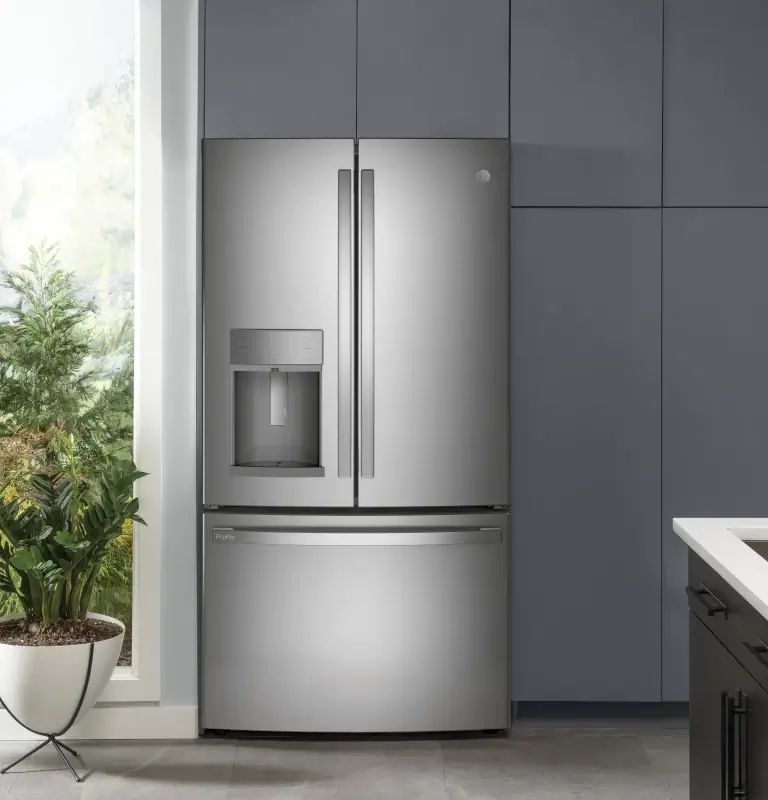
GE Refrigerator Not Cooling
If your GE refrigerator stops cooling, it may be due to a few different things, such as dirty coils, broken fans or relays, incorrect temperature settings, or common causes like bad gaskets or blocked drains. The good news is that one reason your GE refrigerator isn’t cooling could be issues with the evaporator fan. The evaporator fan is what pushes air over the evaporator coils and throughout the freezer and refrigerator compartment. If you notice that your freezer is still cold but the fridge isn’t, there might be something wrong with the evaporator fan.
While some problems can be solved by yourself using a screwdriver, others may require professional assistance, especially when it comes to refrigerator repair. Let’s explore all possible solutions before attempting any repairs and go through the fixes step by step. There may also be some condensation in the bottom of the fridge behind the deli drawer, which is a common issue. Fixing this issue can be fairly easy and inexpensive for the DIY person.
Double Check GE Refrigerator Power Outlet
If your GE fridge isn’t cooling properly, it may be due to a faulty outlet. Check by unplugging the fridge and testing another device in the outlet. If it doesn’t work, the outlet is faulty. If it works fine, do a soft reset by unplugging the fridge for 2 minutes before plugging it back in. Leave at least an inch of space between the back of the fridge and the wall for proper ventilation.
Make sure that the thermostat settings on the control panel inside your fridge are within recommended range. Clean your fridge coils with a vacuum attachment, appliance brush, or coil brush for optimal functionality. A fridge not getting cold enough could indicate a defective cooling system even if fans and compressors are running.
Ensure That GE Refrigerator and Freezer Doors Close Properly
Look at the rubber seals around the doors of your refrigerator. They’re like special gaskets that do an important job. They make sure the door closes tightly and keeps the cold air inside while stopping warm air from getting in.
Now, picture if these rubber seals were broken or not in the right place. The fridge would have a hard time staying cold.
So, when you’re checking your GE fridge for problems, make sure the doors close properly and the rubber seals are snug. If you see a seal that’s not right, gently move it back. But if it looks broken, you might need a new one.
After you’ve checked the seals, close the doors and make sure they seal tightly. If there’s anything inside the fridge, like big trays or food, that’s stopping the doors from closing all the way, take them out. This way, the doors can close properly.
Reset Temperature Controls
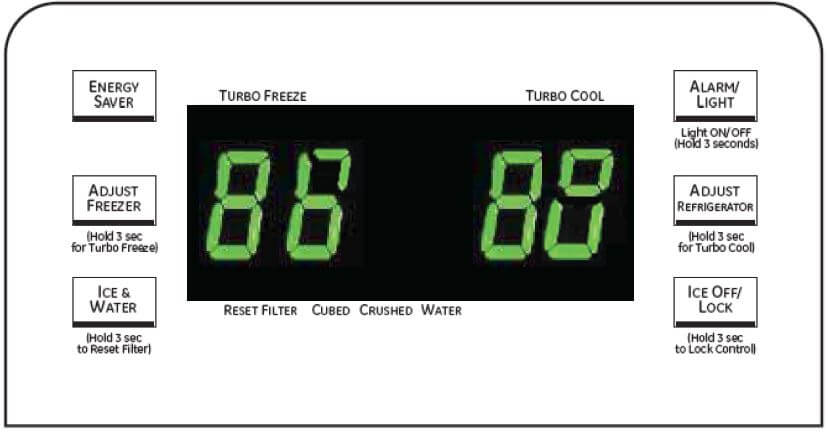
Why It Matters: The settings that control how cold your fridge is are really important. If they’re not right, your fridge might not work well.
The Right Temperature: Experts say it’s best to keep your fridge between 33°F and 40°F. If it’s set higher, it might not keep your food cold enough.
How to Fix It: You can change the temperature settings. Remember, your fridge and freezer have separate controls, so check both.
Checking Over Time: If you’ve had your fridge for a while, it’s a good idea to make sure it’s still working right. You can do this by putting a special thermometer inside for a week.
Making Adjustments: If the thermometer shows the temperature is too high or too low, you can change the settings to make it right again.
That’s it! Making sure your fridge is the right temperature helps keep your food fresh and your fridge working well.
Clean the Condenser Coils
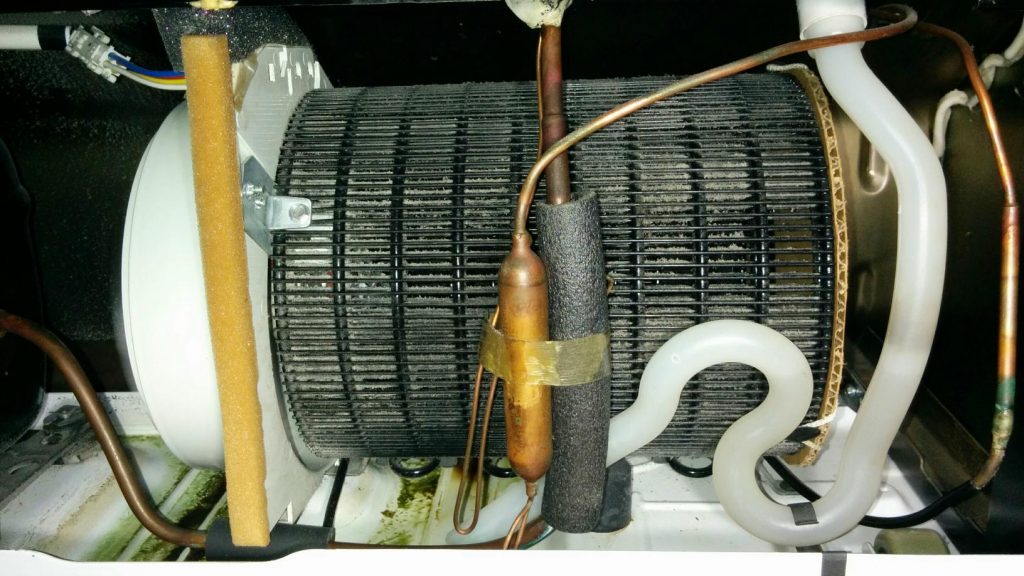
Why It’s Important: We’re going to do something a bit more interesting now. If you’ve come this far, start by unplugging your fridge from the wall. You might also want to move it a bit away from the wall to reach the back easily.
The Problem: When a fridge doesn’t cool properly, it’s often because the coils that help with cooling are dirty.
What are Condenser Coils: These are like special pipes at the back of your fridge. They help make the inside cold by releasing hot air outside. In some fridges, they might stretch to the front.
How They Work: Imagine them like a switch, exchanging hot air for cold air to keep your fridge cool. But if they’re covered in dirt, they can’t do this properly.
Finding and Cleaning Them: Usually, these coils are at the bottom or back of the fridge. Unscrew the cover to get to them. Clean out the vents too, as they help bring in air.
Getting Rid of Dirt: Use a special vacuum attachment to clean the coils. For the tricky spots, a condenser brush can help.
Make Sure It’s Clean: Double-check to be sure all the dirt is gone. Vacuum up any leftover bits. If needed, do it again.
Putting Everything Back: Once it’s all clean, put the cover back and plug in your fridge.
By doing this, you’re helping your fridge work better and keeping your food fresh!
Make Sure the Condenser Fan Is Functioning Properly
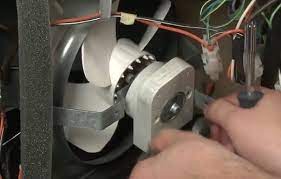
Why It’s Important: The condenser fan is like a helper for your fridge. It’s easy to spot, but many times, people forget to check it.
Where It’s Located: It’s found in the middle of two important parts, the coils and the compressor. Its job is simple: to keep these parts cool by blowing fresh air.
What Happens if It Fails: If the fan stops working or gets stuck, your fridge won’t cool properly. This means your food might not stay cold.
How It Should Work: Normally, when you turn on your fridge, the fan should start spinning. If it doesn’t, there’s a problem.
Checking for Obstructions: Look at the fan’s blades. If something is blocking them, that might be the issue.
Trying to Spin It: If there’s no blockage but it’s still not moving, try giving it a gentle spin with your hand. If it still doesn’t work, the fan’s motor might be broken and you might need a new one.
Looking for Rust: Also, if the fan blades look really rusty, it’s a good idea to think about getting new ones.
By making sure the condenser fan is working, you’re helping your fridge do its job properly!
Examine the Start Relay
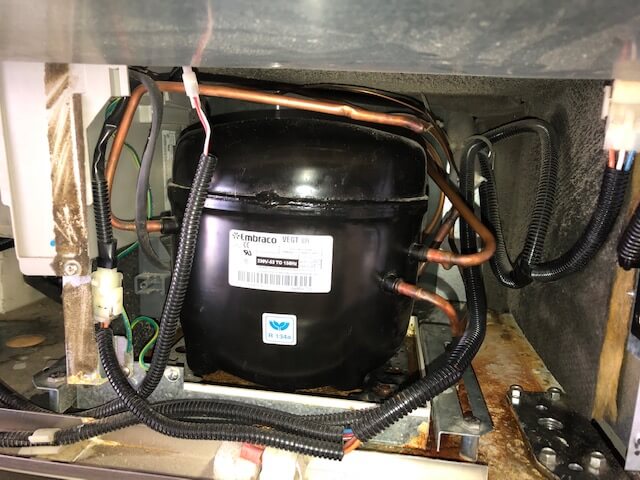
The Start Relay is like a little switch that helps your fridge’s motor (the compressor) start working. If it’s not working, your fridge won’t get cold.
To check if the Start Relay is okay, follow these steps:
1. First, make sure the fan near the back of the fridge is working. It helps keep things cool.
2. Then, listen and feel near the compressor. It’s a round thing attached to tubes. When you turn on the fridge, you should feel it moving a bit or hear a buzzing sound. If you don’t, the Start Relay might be broken.
3. To be sure, unplug the fridge and gently take out the Start Relay. Give it a little shake. If you hear something rattling inside or see small bits coming out, you need to replace it.
4. Another way to check is by listening for a click from the compressor when you turn on the fridge. If it clicks off right away, the Start Relay is probably not working right.
Remember, if you’re not sure about any of this, it’s best to get a professional technician to help you out. They know all about these things!
Verify that the Evaporator Fan Is Working

Why It’s Important: We’re going to look at something called the evaporator fan. Unlike the parts we talked about earlier, this one is at the front of your fridge.
What It Does: The evaporator fan’s job is to take cold air from the coils and spread it all around your fridge. First, it cools the freezer, and then it makes the whole fridge cold. If it’s not working, the cool air won’t go where it should.
How to Know if it’s Broken: If the freezer is nice and cold but the main part of the fridge is still warm, the evaporator fan might be the problem. It might need to be replaced.
One or Two Fans: Some fridges have two of these fans—one for the freezer and one for the main part of the fridge. Others only have one, and it’s usually in the freezer.
Listening for It: To check if it’s working, just listen. You should be able to hear it. If you don’t, there might be an issue.
Making sure the evaporator fan is working is important because it helps spread the cold air in your fridge. If it’s not working right, your food might not stay fresh.
For Refrigerators with a Single Evaporator
- Finding the Fan: In regular GE fridges, you can see the evaporator fan by removing the lights and looking up inside.
- Direct Access: Sometimes, you might need to take out the whole system to get to the fan. Don’t worry, this isn’t too hard.
- Inspecting the Fan: Once you can reach it, look closely to see if it’s working. If not, it might be broken or stuck.
- Simple Test: You can do a quick test with the door switch. This switch controls when the fan starts and stops, and also the fridge’s lights.
- How to Test: Close the fridge doors. This should turn on the fan. You can also pretend to close the doors by pressing the switch. If the fan is okay, it should start in a few seconds.
For Refrigerators with Dual Evaporators
- Where to Look: Some fridges have two of these fans. We’re interested in the one inside the fridge.
- How to Check: Gently open the panels covering the fan. Make sure they’re still partly connected.
- Watch and Wait: Close the fridge doors. After a bit, quickly open them again. You should see the fan still moving before it stops.
- What It Means if It Doesn’t Move: If you’ve tried this a few times and the fan doesn’t move, it’s probably not working properly.
Checking the fan is important because it helps your fridge stay cold. If it’s not working right, your food might not stay fresh.
Examine the Evaporator(s)
If you’ve tried all the previous fixes and you’re sure the fans are working, now we focus on the evaporator.
What’s an Evaporator?
It’s like a system of pipes made of copper that helps make cold air. It’s usually behind the freezer wall.
How it Works:
It makes cold air, and a fan spreads it around the fridge. This is how older GE fridges usually work. Newer ones have two evaporators, one for the freezer and one for the fridge. This helps control the temperatures better.
Why Does This Matter?
If the evaporator isn’t working right, your fridge won’t cool properly.
Remember the old fridges? Newer ones have a fancier setup to keep things cool.

For Refrigerators with a Single Evaporator
- Unplug your fridge from the wall.
- Open the freezer safely.
- Take out all the shelves and unscrew the panel at the back of the freezer. This panel covers the evaporator coils.
- Look closely: Is there ice on the coils or the panel? If yes, the defrost thermostat at the top of the coils might be having trouble.
- Check the thermostat’s lid. If it looks swollen, it might need replacing.
- If the thermostat seems fine, you can test it with a special tool called a multimeter. But be careful, it’s a bit tricky. You might want to call a pro.
- Now, look at the defrost heater. It’s under the coils and it helps melt any ice. It turns on every few hours.
- You might need to take it out to really check. You’ll need a multimeter for this too. A working defrost heater should give a reading between 20 to 40 Ohms.
For Refrigerators with Dual Evaporators
- Unplug your fridge.
- Open both fridge doors.
- Take out all the food, shelves, and drawers.
- Unscrew the panel covering the coils.
- Now, you can see the coils. Look underneath for the defrost heater. It does the same job as before.
- If there’s too much ice, give it some time to melt.
- Sometimes, if the fridge doors are left open too long, moisture can cause extra ice. So, let it thaw out.
- Plug your fridge back in and wait to see if it starts working properly. If not, you might need to change either the defrost heater or the evaporator fan.
Check the Defrost Timer
An improperly set defrost timer could be another reason why your GE refrigerator is failing to cool adequately. This timer is responsible for ensuring that the refrigerator’s temperature stays within the desired range.
If you accidentally set it too low, the impact will be evident: your refrigerator won’t cool properly.
To reset the defrost timer, begin by unplugging the refrigerator. Then, remove all the items from the lower shelf of the freezer door.
Next, press and hold the Freezer button for a few seconds or until it starts blinking. From there, you can either set a new timer or turn it off entirely.
Inspect the Defrost Drain
Your fridge is like a well-oiled machine, where every part has a specific job. If one part breaks, it can mess up the whole system.
In your fridge, there are evaporator coils that keep things cool, and a defrost heater that prevents ice from building up on these coils.
When the ice melts, it turns into water. Usually, this water goes into the fridge’s defrost drain. But sometimes, this drain can get clogged by stuff like debris.
When that happens, the defrost heater can’t melt all the ice, and extra water turns into more ice during the “frost cycle.”
This extra ice might be the reason your fridge isn’t cooling properly.
Here’s how to fix it:
Unplug your fridge and wait a bit for it to thaw. Then, use something like forced air to clear out any blockages in the drain.
For Refrigerators with a Single Evaporator
In traditional GE refrigerators with a single evaporator, the defrost drain is located in the freezer, beneath the evaporator coils.
For Refrigerators with Dual Evaporators
In refrigerators with dual evaporators, the defrost drain is positioned in the refrigerator, directly under the evaporator coils.
When You Need to Order Replacement Parts for GE Refrigerator
If you’ve followed our advice and identified a broken part in your GE refrigerator, you’ll need to get a new one. It’s easy! Just remember your fridge’s exact model number and go to Sears Parts Direct. There, you can find the specific part you need and order it.
You can find your fridge’s model number on the inside wall. Look for a sticker with all the important info.
GE Refrigerator User Manual
If you are having issues with your GE refrigerator not cooling, don’t worry. You can find useful information in your user manual. If you’ve misplaced it, no problem. Just go to GE.com and search for your model number.
This will allow you to download an electronic version of the manual from the website. Additionally, if you are in need of any replacement parts such as a thermostat, condenser fan, or ice maker, GE offers a variety of options to keep your refrigerator up and running smoothly.
GE Customer Support
If you’ve tried all our solutions and your GE fridge still isn’t cool, trained experts may be needed. Contact them at 1-800-432-2737 on weekdays between 8 am and 7 pm EST. If you want a technician to check your refrigerator at home, schedule a service appointment online for appliance repair. If it’s under warranty, the service cost may be covered.
FAQs
Why is my GE fridge not cold?
Overcrowding is frequently to blame when a GE refrigerator won’t chill, although we may all occasionally be guilty of it. This is due to the fact that a refrigerator’s air vents might become blocked by an excessive amount of things, rendering them incapable of cooling. Cooling may also be hampered by restricted airflow between tightly packed objects.
What kills a refrigerator compressor?
Over time, liquid refrigerant can cause the compressor motor insulation to ping and deteriorate, which can lead to motor failure. A lubrication breakdown occurs when liquid refrigerant pushes compressor oil out of the compressor and into the system.
Is it possible for the freezer to work but not the fridge?
Yes. The issue is likely related to one of your refrigerator’s systems not operating as intended if the refrigerator is not cool but the freezer is.
Conclusion
GE refrigerators may stop cooling. This can be caused by a dirty condenser coil, faulty evaporators, a malfunctioning start relay, or a problematic evaporator fan. Thankfully, these issues usually have easy solutions that we’ll discuss in this guide. Our recommendations will help you find and fix the problem quickly. If you need professional assistance, we’ll also help you find it.
Jeegna
Greetings, tech enthusiasts! I'm Jeegna, your go-to guru for all things gadget-related. With a passion for technology that runs deep, I've made it my mission to unravel the mysteries of the digital world and simplify it for you.Related Posts
- Samsung Dishwasher Not Draining
- Bosch Refrigerator Not Cooling
- Hisense Refrigerator Not Cooling: Troubleshooting Guide
- Frigidaire Refrigerator Not Cooling
- Maytag Refrigerator Not Cooling
- Samsung Refrigerator Not Cooling
- LG Refrigerator Not Cooling
- KitchenAid Refrigerator Not Cooling
- Amana Refrigerator Not Cooling
- Kennore Refrigerator Not Cooling
- Insignia TV Volume Stuck
- TCL TV Volume Stuck (Easy Fix Steps)
- Sony TV No Sound (Don’t Miss a Beat)
- Apple TV Volume Stuck (Troubleshooting Guide)
- LG TV Volume Stuck (Quick & Easy Fix)
- Samsung TV Volume Stuck (This Quick Trick Could Save Your Day!)
